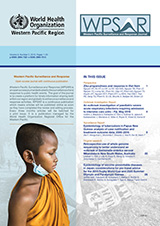Epidemiology of vaccine-preventable diseases in Japan: considerations for pre-travel advice for the 2019 Rugby World Cup and 2020 Summer Olympic and Paralympic Games
DOI:
https://doi.org/10.5365/wpsar.2017.8.4.002Abstract
Introduction: In 2019 and 2020, Japan will host two international sporting events estimated to draw a combined 22 million visitors. Mass gatherings like these ones increase the risk of spread of infectious disease outbreaks and international transmission. Pre-travel advice reduces that risk.
Methods: To assist ministries of health and related organizations in developing pre-travel advice, we summarized national surveillance data in Japan (2000–2016, to the extent available) for rubella, invasive pneumococcal disease, measles, non-A and non-E viral hepatitis, hepatitis A, invasive Haemophilus influenzae disease, tetanus, typhoid fever, invasive meningococcal disease, Japanese encephalitis, influenza, varicella, mumps and pertussis by calculating descriptive statistics of reported cases and reviewing trends. (See Annex A for details of reviewed diseases.)
Results: Our findings showed notable incidences of rubella (1.78 per 100 000 person-years), influenza (243.5 cases per sentinel site), and mumps (40.1 per sentinel site); seasonal increases for influenza (November–May) and Japanese encephalitis (August–November); and a geographical concentration of Japanese encephalitis in western Japan. Measles cases decreased from 11 013 in 2008 to 35 in 2015, but outbreaks (n = 165 cases) associated with importation occurred in 2016. Though invasive meningococcal disease incidence was only 0.03 per 100 000, international transmission occurred at a mass gathering in Japan in 2015.
Discussion: Ministries of health and related organizations should use these findings to develop targeted pre-travel advice for travellers to the 2019 Rugby World Cup and the 2020 Summer Olympic and Paralympic Games, especially for mumps, measles, rubella, influenza, and meningitis. Travellers with increased exposure risk should also be advised about hepatitis A and Japanese encephalitis.
References
Mizuho Research Institute. The Economic Impact of the 2020 Tokyo Olympic Games. [Internet] 2014 Oct [cited: 2016 Aug 23]. Available from: http://www.mizuho-ri.co.jp/publication/research/pdf/eo/MEA141017.pdf.
World Health Organization. Public health for mass gatherings: key considerations. Geneva: WHO Press; 2015.
Gautret P, Steffen R. Communicable diseases as health risks at mass gatherings other than Hajj: what is the evidence? Int J Infect Dis. 2016; 47:46-52.
Santibanez K, Prosenc K, Lohr D, Pfaff G, Jordan Markocic O, Mankertz A. Measles virus spread initiated at international mass gatherings in Europe, 2011. Euro Surveill. 2014; 19(35):pii=20891.
World Health Organization. Brazil - Health advice for travellers to the 2016 Summer Olympic and Paralympic Games. [Internet] 2016 Sep [cited: 2017 Sep 1]. Available from: http://www.who.int/ith/updates/20160621/en/.
Alqahtani AS, Wiley KE, Tashani M, Willaby HW, Heywood AE, BinDhim NF, et al. Exploring barriers to and facilitators of preventive measures against infectious diseases among Australian Hajj pilgrims: cross-sectional studies before and after Hajj. Int J Infect Dis. 2016; 47:53-59.
National Institute of Infectious Diseases. [Case study of food poisoning by typhoid presumed to be caused by raw salad – Tokyo]. IASR monthly report. 2015; 36(8):162-163. Japanese.
Fukusumi M, Kamiya H, Takahashi H, Kanai M, Hachisu Y, Saitoh T, et al. National surveillance for meningococcal disease in Japan, 1999–2014. Vaccine. 2016; 34(34):4068–71.
Kanai M, Kamiya H, Smith-Palmer A, Takahashi H, Hachisu Y, Fukusumi M, et al. Meningococcal disease outbreak related to the World Scout Jamboree in Japan, 2015. Western Pac Surveill Response J. 2017; 8(2):25–30.
National Institue of Infectious Diseases. Measles in Japan, as of March 2015. IASR monthly report. 2015;36(4): 51–53.
National Institute of Infectious Diseases. [Outbreak of measles in business offices in Kansai International Airport]. IASR monthly report. 2017; 38(3):48-49. Japanese.
National Institute of Infectious Diseases. Hepatitis A in Japan, 2010-2014, as of November 2014. IASR monthly report. 2015; 36(1):1-2.
National Institue of Infectious Diseases. [On the results of the investigation of the vaccination history of "mumps vaccine" in recent years]. IASR monthly report. 2016; 37(10):198-199. Japanese.
Ihekweazu C, Basarab M, Wilson D, Oliver I, Dance D, George R, et al. Outbreaks of serious pneumococcal disease in closed settings in the post-antibiotic era: A systematic review. J Infect. 2010;61(1):21-27.
National Institue of Infectious Diseases. Rubella and congenital rubella syndrome in Japan, as of March 2013. IASR monthly report. 2013;34(4):87-89.
National Institute of Infectious Diseases. National epidemiological surveillance of vaccine-preventable diseases, 2016: Age distribution of rubella HI antibody positives in Japan, 2016. [Internet] 2017 Mar [cited 2017 Sep 26]. Available from: https://www.niid.go.jp/niid//images/epi/yosoku/Seroprevalence/r2016serum-e.pdf.
National Institute of Infectious Diseases. Rotavirus, 2010-2013. IASR monthly report. 2014;35(3): 63-64.
The Research Institute of Tuberculosis JATA. Annual reports 2015 summary/foreigner. [Internet] 2016 Sep 1 [cited 2017 Sep 12.] Available from: http://www.jata.or.jp/rit/ekigaku/en/annual-reports/.
Teutsch, SM. Considerations in planning a surveillance system. In: Lee LM, Teutsch SM, Thacker SB, St. Louis ME, editors. Principles & practice of public health surveillance. 3rd ed. New York: Oxford University Press; 2010. p. 22.

